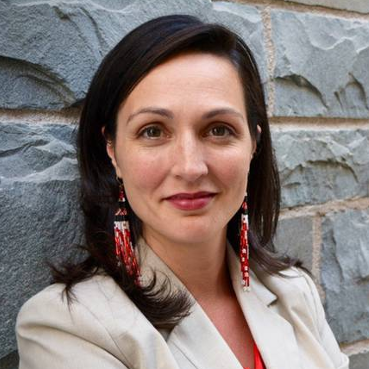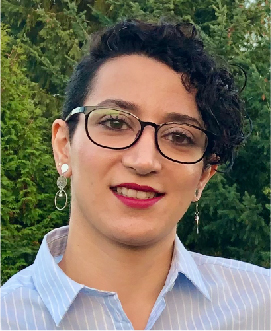Dorothy J Killam Memorial Graduate Prize
The Dorothy J Killam Memorial Graduate Prizes were created in the fall of 2002 to honor the memory of Dorothy J Killam.
Three prizes are awarded annually to the most outstanding Killam Memorial Scholarship recipients.The recipients are selected based on academic achievement, research proposal, letters of recommendation, and leadership qualities.
Recipients receive a cash prize of $5,000 and a certificate acknowledging their award.
2021 Recipients
Naiomi Metallic, Law
Finding Spaces for Indigenous Law in Canada
 Before Europeans' arrival, Indigenous people had laws. They still have laws today. While those laws have been harmed by colonialism and suppressed by Canadian legal orders for much of this country’s history, Indigenous laws are making a comeback. Recently, Indigenous law scholars have led ground-breaking work, providing conclusive answers to the ‘why’ and making important strides into the ‘how’ of Indigenous law, in particular identifying resources and methods for their revitalization. My project will support this vital work by tackling further key ‘how’ questions, addressing significant gaps in knowledge about how Indigenous laws can be implemented within the Canadian state.
Before Europeans' arrival, Indigenous people had laws. They still have laws today. While those laws have been harmed by colonialism and suppressed by Canadian legal orders for much of this country’s history, Indigenous laws are making a comeback. Recently, Indigenous law scholars have led ground-breaking work, providing conclusive answers to the ‘why’ and making important strides into the ‘how’ of Indigenous law, in particular identifying resources and methods for their revitalization. My project will support this vital work by tackling further key ‘how’ questions, addressing significant gaps in knowledge about how Indigenous laws can be implemented within the Canadian state.
Read more:
- "Two PhD students awarded prestigious scholarships" (Faculty of Law)
- "Dalhousie professor of Aboriginal law pursuing PhD at UAlberta's Faculty of Law" (Faculty of Law)
Kim Cuong Nguyen, Radiology & Diagnostic Imaging
Imaging dental issues using ionizing radiation-free ultrasound
 Crowding and misalignment of teeth, known as malocclusion, can cause patients oral functioning problems such as jaw movement, chewing, speech, and high sensitivity to periodontal diseases. Correction of the malocclusion requires orthodontic treatment. Cone-beam computer tomography has been routinely used in orthodontic diagnosis and treatment planning by delivering more hazardous ionizing radiation than conventional dental X-ray. The accumulated radiation dose can be significant due to repeated monitoring visits. The proposal will develop ultrasound as an innovative, ionizing radiation-free, less-costly, portable, and non-invasive clinical diagnostic tool to image dental tissue complex. If successful, the orthodontic patients will stand to benefit from the decreased radiation and reduced cancer rate.
Crowding and misalignment of teeth, known as malocclusion, can cause patients oral functioning problems such as jaw movement, chewing, speech, and high sensitivity to periodontal diseases. Correction of the malocclusion requires orthodontic treatment. Cone-beam computer tomography has been routinely used in orthodontic diagnosis and treatment planning by delivering more hazardous ionizing radiation than conventional dental X-ray. The accumulated radiation dose can be significant due to repeated monitoring visits. The proposal will develop ultrasound as an innovative, ionizing radiation-free, less-costly, portable, and non-invasive clinical diagnostic tool to image dental tissue complex. If successful, the orthodontic patients will stand to benefit from the decreased radiation and reduced cancer rate.
Read more:
- "From bench to bedside — Research that improves patient oral care" (Faculty of Medicine & Dentistry)
Joshua Hefler, Surgery
2020 Recipients
Rezvaneh Erfani Hossein Pour, Sociology
Imagining a New Environmentalism: Social and Political Capacities of Environmental Activism in the Middle East
 Although Western environmental activism has been widely researched, environmentalism and environmental advocacy in politically closed societies are understudied and poorly understood, particularly when it comes to the Middle East. Rezvaneh Erfani's doctoral research project explores interrelations of authoritarianism, civil society and environmental activism in non-Western contexts. Focusing on gender, identity, and citizenship, in this research she asks: how is environmentalism understood and practiced in the Middle East? Her research explores whether and how activists facilitate social change and democratization and also examines the relevance of existing environmental movement literature to Middle East contexts through conducting interviews with environmental activists and ethnographic fieldwork within environmental nongovernmental organizations (NGOs) in Egypt and Türkiye, two Muslim majority societies with the largest populations in the region. Environmental sociologists have shown that not all societies and cultures respond to ecological problems in the same way. We therefore need to produce more knowledge on specificities and diversities of these reactions and responses to be able to imagine possible ways to cope with climate crisis that we are all facing and to bridge policies of elite-controlled institutions to practices of grassroots organizations with various capacities and challenges across the globe.
Although Western environmental activism has been widely researched, environmentalism and environmental advocacy in politically closed societies are understudied and poorly understood, particularly when it comes to the Middle East. Rezvaneh Erfani's doctoral research project explores interrelations of authoritarianism, civil society and environmental activism in non-Western contexts. Focusing on gender, identity, and citizenship, in this research she asks: how is environmentalism understood and practiced in the Middle East? Her research explores whether and how activists facilitate social change and democratization and also examines the relevance of existing environmental movement literature to Middle East contexts through conducting interviews with environmental activists and ethnographic fieldwork within environmental nongovernmental organizations (NGOs) in Egypt and Türkiye, two Muslim majority societies with the largest populations in the region. Environmental sociologists have shown that not all societies and cultures respond to ecological problems in the same way. We therefore need to produce more knowledge on specificities and diversities of these reactions and responses to be able to imagine possible ways to cope with climate crisis that we are all facing and to bridge policies of elite-controlled institutions to practices of grassroots organizations with various capacities and challenges across the globe.
Read more:
- "The Faculty of Arts' 2020 Killam laureates: Outstanding researchers, students recognized with prestigious award" (Faculty of Arts)
- "In terms of global environmentalism - one size does not fit all, especially in the Middle East" (Faculty of Arts)
Fatal Attraction: Evaluation and Engineering Insect-killing Molds for the Biocontrol of the Invasive Mountain Pine Beetle
 The mountain pine beetle (MPB) epidemic has infested ~16 Mha of British Columbia killing >50% of mature lodgepole pine. At present, it is functionally an invasive species in Alberta, killing and reproducing in evolutionarily naïve populations of lodgepole pine, jack pine, and lodgepole x jack hybrids. The Alberta government has already spent ~$500 million on mitigation efforts, which are currently limited on locating burning infested trees. An assessment of the insect-killing mold, Beauveria bassiana against the MPB as a biological control agent was done to slow down the spread of the epidemic. B. bassiana is an approved bio-control agent in agricultural settings to control insect pests. World wide B. bassiana collections were screened and phenotypically characterized for virulence factors against the MPB. The molds were categorized based on pigment production, spore density, and colonization rate. Although the fungus can colonize other insects, honeybee infection model revealed ~3-5% mortality, representing the natural turnover of the hive population. Conversely, results indicated 100% killing and infection against laboratory-reared MPBs. Furthermore, to make the fungus selective against MPB, engineering of the unique beetle aggregation pheromone pathways into the mold will be done that will result in a targeted fatal attraction. A scenario where mold-infected dead beetles will now produce the pheromone and will attract only the MPBs and a cascade of fatal attraction (i.e. a domino effect) is expected. This is the first account utilizing B. bassiana as a biological control agent of MPB in Western Canada.
The mountain pine beetle (MPB) epidemic has infested ~16 Mha of British Columbia killing >50% of mature lodgepole pine. At present, it is functionally an invasive species in Alberta, killing and reproducing in evolutionarily naïve populations of lodgepole pine, jack pine, and lodgepole x jack hybrids. The Alberta government has already spent ~$500 million on mitigation efforts, which are currently limited on locating burning infested trees. An assessment of the insect-killing mold, Beauveria bassiana against the MPB as a biological control agent was done to slow down the spread of the epidemic. B. bassiana is an approved bio-control agent in agricultural settings to control insect pests. World wide B. bassiana collections were screened and phenotypically characterized for virulence factors against the MPB. The molds were categorized based on pigment production, spore density, and colonization rate. Although the fungus can colonize other insects, honeybee infection model revealed ~3-5% mortality, representing the natural turnover of the hive population. Conversely, results indicated 100% killing and infection against laboratory-reared MPBs. Furthermore, to make the fungus selective against MPB, engineering of the unique beetle aggregation pheromone pathways into the mold will be done that will result in a targeted fatal attraction. A scenario where mold-infected dead beetles will now produce the pheromone and will attract only the MPBs and a cascade of fatal attraction (i.e. a domino effect) is expected. This is the first account utilizing B. bassiana as a biological control agent of MPB in Western Canada.
Read more:
- "Two PhD students honoured with prestigious Dorothy J. Killam Memorial Graduate Prize" (Faculty of Science)
- "Early inspiration brings international PhD students to the University of Alberta" (Faculty of Science)
Cell Shrinkage after Severe Hemorrhagic Stroke
 Intracerebral hemorrhage, a bleed in the brain, is a devastating stroke. The blood clot occupies space in the skull, leading to pressure increases. Many patients die because of rising pressure within the skull, and the same is true in rat models. Interestingly, in rat models, brain cells shrink after large strokes, likely to compensate for the high pressure and make space for the clot. Cell shrinkage could be lifesaving, preventing lethal pressure increases. However, brain cells require a tightly regulated environment to function, and drastic changes to cells could cause damage and impair function. The objectives of this research are to learn how this cell shrinkage happens and how it affects outcome. A clinical study will determine if cell shrinkage happens in stroke patients or if this phenomenon is unique to rodents. Studies in animal models will prevent pressure increases using shunting and determine if this prevents cell shrinkage. Mechanistic studies will measure gene expression using transcriptomics to determine which proteins regulate this cell shrinkage, and with this knowledge, we can identify drugs that can either block or augment this phenomenon. These studies will answer fundamental questions about this potentially life-saving mechanism that may lead to therapies for severe strokes.
Intracerebral hemorrhage, a bleed in the brain, is a devastating stroke. The blood clot occupies space in the skull, leading to pressure increases. Many patients die because of rising pressure within the skull, and the same is true in rat models. Interestingly, in rat models, brain cells shrink after large strokes, likely to compensate for the high pressure and make space for the clot. Cell shrinkage could be lifesaving, preventing lethal pressure increases. However, brain cells require a tightly regulated environment to function, and drastic changes to cells could cause damage and impair function. The objectives of this research are to learn how this cell shrinkage happens and how it affects outcome. A clinical study will determine if cell shrinkage happens in stroke patients or if this phenomenon is unique to rodents. Studies in animal models will prevent pressure increases using shunting and determine if this prevents cell shrinkage. Mechanistic studies will measure gene expression using transcriptomics to determine which proteins regulate this cell shrinkage, and with this knowledge, we can identify drugs that can either block or augment this phenomenon. These studies will answer fundamental questions about this potentially life-saving mechanism that may lead to therapies for severe strokes.
Read more:
- "Two PhD students honoured with prestigious Dorothy J. Killam Memorial Graduate Prize" (Faculty of Science)